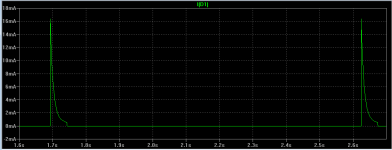Ever since the days of the now-obsolete LM3909 chip, I've been interested in "Charge Efficient" circuits that flash LEDs. By that I mean, each and every picoCoulomb of charge that is drawn from the supply, ideally SHOULD flow through the LED and provide light. Charge drawn from the supply and shunted to ground without flowing thru the LED, via bias resistors etc., is charge wasted. I define Charge Efficiency (CE) to be
CE = (Charge that flows thru LED) / (Charge drawn from supply)
both are measured over the same interval of time.
Flashing an LED using the LM3909 was surprisingly Charge-Efficient, *IF* operated from a 1.5 volt supply. But when you ran it from +12V, yuck. It's been a little hobby of mine to build 12V Charge-Efficient LED flashers, and I thought I might let diyAudio members have some fun with it, too. I'll express the design problem as an "Etude" (definition: A short musical composition, typically for one instrument, designed as an exercise to improve the technique or demonstrate the skill of the player) but really the goal is to design some circuits and have some fun.
CHARGE-EFFICIENT LED FLASHER ETUDE
1) Power Supply: 12V +/- 10%
2) LED type: normal brightness, red, T-1 size, commodity part
3) LED flash rate: approx 1 flash per second
4) LED current: approx 20 msec pulse width, approx 15 milliamps pulse height
5) Solid-State only; no vacuum tubes!
6) Discrete devices slightly preferred; ICs slightly deprecated
7) Micropower opamps (LM4250, LT1494 et al) strictly verboten
The best I was able to do circa 1990 was about 66% charge efficiency: Supply average current was 300 uA, LED average current was 200 uA. (Average current means the integral of the current waveform, divided by the period). But new ideas have come along and my designs are considerably more efficient today.
I think YOU may enjoy fooling around with charge efficient LED flashers too. They are small, easily breadboarded, contain no dangerous voltages or temperatures, amenable to hand-analysis, and easy to SPICE as well. What's not to like? Give it a try, have some fun.
I'm attempting to attach a picture of the current waveform through the LED of my latest design. Parts have been ordered but not yet delivered, so, yes this is a simulation (gasp!). It happens to be a 3 (discrete) transistor circuit, but I find that transistor count and charge efficiency don't always correlate; few transistors often means worse efficiency. Or, maybe that's just a reflection of my ineptitude at designing small device-count circuits.
I'll post my circuit in a month or so, after I've built it. Meanwhile, fool around with the idea, do the Etude, have some fun! Post your circuits here if you feel like it.
MarkJ
(Sorry if I chose the wrong Forum to post this; if so, please indicate where you think it SHOULD go.)
CE = (Charge that flows thru LED) / (Charge drawn from supply)
both are measured over the same interval of time.
Flashing an LED using the LM3909 was surprisingly Charge-Efficient, *IF* operated from a 1.5 volt supply. But when you ran it from +12V, yuck. It's been a little hobby of mine to build 12V Charge-Efficient LED flashers, and I thought I might let diyAudio members have some fun with it, too. I'll express the design problem as an "Etude" (definition: A short musical composition, typically for one instrument, designed as an exercise to improve the technique or demonstrate the skill of the player) but really the goal is to design some circuits and have some fun.
CHARGE-EFFICIENT LED FLASHER ETUDE
1) Power Supply: 12V +/- 10%
2) LED type: normal brightness, red, T-1 size, commodity part
3) LED flash rate: approx 1 flash per second
4) LED current: approx 20 msec pulse width, approx 15 milliamps pulse height
5) Solid-State only; no vacuum tubes!
6) Discrete devices slightly preferred; ICs slightly deprecated
7) Micropower opamps (LM4250, LT1494 et al) strictly verboten
The best I was able to do circa 1990 was about 66% charge efficiency: Supply average current was 300 uA, LED average current was 200 uA. (Average current means the integral of the current waveform, divided by the period). But new ideas have come along and my designs are considerably more efficient today.
I think YOU may enjoy fooling around with charge efficient LED flashers too. They are small, easily breadboarded, contain no dangerous voltages or temperatures, amenable to hand-analysis, and easy to SPICE as well. What's not to like? Give it a try, have some fun.
I'm attempting to attach a picture of the current waveform through the LED of my latest design. Parts have been ordered but not yet delivered, so, yes this is a simulation (gasp!). It happens to be a 3 (discrete) transistor circuit, but I find that transistor count and charge efficiency don't always correlate; few transistors often means worse efficiency. Or, maybe that's just a reflection of my ineptitude at designing small device-count circuits.
I'll post my circuit in a month or so, after I've built it. Meanwhile, fool around with the idea, do the Etude, have some fun! Post your circuits here if you feel like it.
MarkJ
(Sorry if I chose the wrong Forum to post this; if so, please indicate where you think it SHOULD go.)
